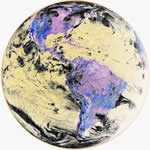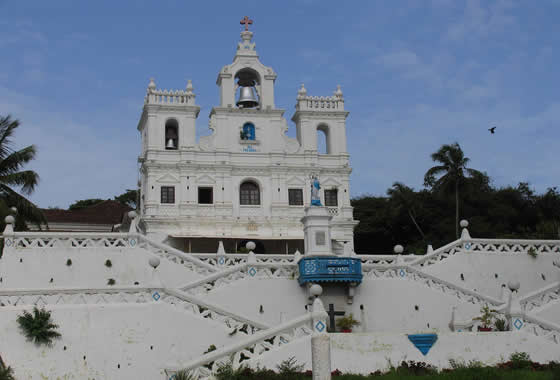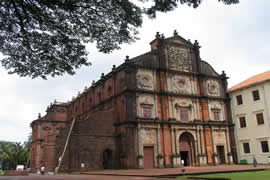The Psychedelic Waves of Goa
By Brook & Gaurav Bhagat

White sand beaches, palm trees, lush green farms and dark beauties with fresh flowers in their hair; all-night beach parties, naked chillum-smoking sadhus and booming discotheques; ancient temples and haunted, old-European churches... like everyone else traveling in India, we had heard plenty of stories about Goa, and were finally going to see for ourselves what was real. As we bounced south though the night on a sleeper train, our dreams were full of the mysterious legends and contradictions that made up our image of the smallest, and maybe strangest, state of India.
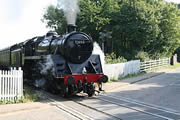
At 5:30 a.m., the train squealed to a stop at the station of Karmali. As we stumbled off the train into the cool pre-dawn light, a rush of excitement filled our lungs: it was true! A heavy mist hung around the palm trees and rolling green hills; dewdrops evaporated in the sun’s first rays, and we took slow, deep breaths of the clean, fresh air. This was it. Goa.
We boarded an autorickshaw bound for the beaches of Anjuna, which went with good speed on the winding, well-paved roads. Over the hills and around every bend, the window was full of green: farms, trees, plants, vines, everything lush and alive. Goa is a network of small towns, basically, and a few small cities; we were amazed that the natural beauty and magnificent landscapes between them were so well-preserved after decades of heavy tourist traffic.
We reached Anjuna and found lodging, which was a little difficult as the peak tourist season in Goa centers around the celebrations of Christmas and New Year’s. It was nearly February, but many hotels and guest houses were still full, or asking peak-season prices. By Western standards Goa isn’t costly, as it is still India and the exchange rate is advantageous (Rs. 55= US $1); but for us, earning by Indian standards, it was an expensive place to visit. Goa has the highest per capita income in the country, and, of course, a flourishing tourist trade, so these factors are reflected in the prices.
After cleaning up, we headed straight for the ocean, following a well-worn path populated 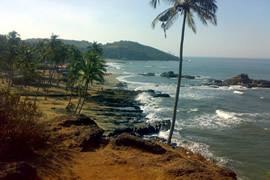 by a steady trickle of travelers. Anjuna’s beaches are more rocky than sandy, and we collected beautiful shells, sea-glass and stones; we found tiny fish in tide pools, and crabs scurrying over the reddish, iridescent coral. We went out as far as we could go, jumping rock-to-rock as the waves crashed around us. The landscape was like a 3-D postcard-- rocky cliffs in the distance, palm trees and coconuts, bright blue sky and high white clouds.
by a steady trickle of travelers. Anjuna’s beaches are more rocky than sandy, and we collected beautiful shells, sea-glass and stones; we found tiny fish in tide pools, and crabs scurrying over the reddish, iridescent coral. We went out as far as we could go, jumping rock-to-rock as the waves crashed around us. The landscape was like a 3-D postcard-- rocky cliffs in the distance, palm trees and coconuts, bright blue sky and high white clouds.
Down on the beach, a woman and small child were collecting seaweed from the shoreline in woven baskets, and tossing it in a growing heap on the sand. They didn’t turn their heads to the electronic ring of cell phones or the babble of tourists; they didn’t notice that one of them was silently capturing their timeless work on a video camera, and what was an ordinary day for them had become a precious souvenir for someone else.
Like anywhere in the world, Goa is a place where many worlds coexist simultaneously. For the young and willing, one of them is a year-round party scene which hits its peak on Christmas and New Year’s Eve. Discotheques, clubs and beach shacks throb with trance music, alcohol, and other intoxicants. The unique fusion of techno music and Indian instruments born in these bars and on these beaches has even won its own musical genre, known as “Goa Trance," now found in music stores around the world.
But creation and destruction grow from the same roots; in February, the Anjuna scene was little more than a handful of seedy neo-hippies, some of them barely teenaged, who looked like they had spent their train money on partying and had nowhere else to go. The drug culture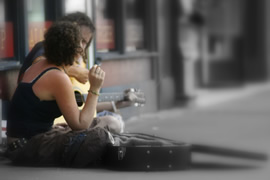 that was imported in the 60’s and 70’s is still very much alive, and has become big business on both the white and black markets, feeding on the young people who many times end up willing exploitees of the hype. One night, we saw a young girl and an older man smoking from a chillum (despite a large sign prohibiting it) near us in a beachfront restaurant; behind her, a psychedelic mural of Alice in Wonderland danced to the sound of the crashing waves. Her eyes, however, were motionless, as still as her thin, pale hand, resting on an open backpack.
that was imported in the 60’s and 70’s is still very much alive, and has become big business on both the white and black markets, feeding on the young people who many times end up willing exploitees of the hype. One night, we saw a young girl and an older man smoking from a chillum (despite a large sign prohibiting it) near us in a beachfront restaurant; behind her, a psychedelic mural of Alice in Wonderland danced to the sound of the crashing waves. Her eyes, however, were motionless, as still as her thin, pale hand, resting on an open backpack.
Restaurants, clothing shops and doubtlessly local criminals cater to the continuous wave of intoxicated foreigners and their Western tastes. American cigarettes, beer and chocolate brownies are available alongside paan and bidis in almost every corner shop; Bob Marley and Pink Floyd seemed to hold a monopoly on the sound waves of the main street of Anjuna, and it wasn’t long before we were ready for a change of pace.
For those tourists who prefer a more sober, if equally (or probably more) splendid time, there are plenty of other scenes and worlds available in Goa. It must be duly noted, however, that Goa offers some of the best port wines in the world, along with its famous feni, a strong and very stinky wine made from locally-grown cashew nuts, which comes in dozens of varieties.
We shifted to the more upscale town of Candolim, just a short walk from the white-sand beach. Here, hippies were less, and the affluent tourist trade was in full swing-- at least one out of three people was from abroad. In Candolim and nearby Calangute, world-class shopping is available, along with fine dining, music and art museums.
Our Candolim routine, however, centered around getting up and heading for the ocean as soon as possible. The beach is lined with “shacks"-- small restaurants which vary in their provisions for customers. Some offer just alcohol and snacks, and others sell full meals; almost all, however, provide lounge chairs and small squares of shade to relax in. Our home base was “Pete’s Shack," where, after swimming,  we usually opted for the Indian cuisine. Goan chicken, kingfish curry, Chinese fried rice and Continental tuna or avocado salads were all made with mouth-watering skill; great music, reading material and Osho ambiance added to its warmth and charm.
we usually opted for the Indian cuisine. Goan chicken, kingfish curry, Chinese fried rice and Continental tuna or avocado salads were all made with mouth-watering skill; great music, reading material and Osho ambiance added to its warmth and charm.
One evening, we were lucky enough to be present for the beginning of an Osho meditation camp. As the sun began to melt into the sea, a group of thirty or forty sanyasins sat or danced at the edge of the water to the beat of the drums; when night fell, we lit a campfire. For a few sweet hours, we were out of time altogether, singing and listening to Ashva Bodhi play the guitar, talking, laughing, and finally gazing silently into the embers of existence.
The daytime Candolim beach was beautiful, sparsely populated and unpolluted. Free of locals hawking goods or services or begging, unlike more well-known sections of the Goa coastline, visitors felt comfortable to go topless, sleep, or generally relax in the natural lullaby of the ocean.
In the Goan world of the sea, like the world of partying, it’s easy to get in over your head... where we were, the waves generally got rougher as the day went on, so we tried to reach by noon or one o’clock. We bodysurfed, swam and played like children. Fun as it was, usually after about an hour we had had enough exercise (and swallowed enough saltwater and sand), that we were ready for a break. Each day, the water conditions were distinctly different from the day before-- sometimes rougher, sometimes calmer; the water pulled us in different ways and directions. Be sure to ask locals about weather conditions, undercurrents and tides; the ocean, like all mothers, knows she has brought you into this life, and reserves her right to take you out.
The next Goan scene we dove into was that of history. We rented a motorcycle for just Rs. 125 (less than US $3) per day, and began exploring. Goa was ruled by the Portuguese from 1510 to 1961; the most obvious evidence of this is the thousands of churches that range in size from one-room steeples to monumental cathedrals, and in age from nearly 500 years old to the present. From the sixteenth century onwards, the Portuguese left their mark on the land, culture, language, religion and literally in the blood of the people. During the Inquisition, Goa became a stronghold of Christianity in India; even today, it remains more than 30% Christian, and devoutly so. In Calangute, one church is located on an island separating two small highways; in the evenings, it was a common sight to see churchgoers crowded not only outside the church, but literally out into the street, singing hymns as if oblivious to the traffic whizzing by. Now, that’s real faith.
Our daily excursions led us first to Old Goa, where we were overwhelmed with the ornate craftsmanship and passionate artwork which adorn the monuments of Goa’s past, and in many cases still serve present-day congregations. Two of the most famous and best-preserved cathedrals sit across the highway from each other at the center of Old Goa: on the right, coming from the capital of Panjim, is the Cathedral of St. Catherine da Se. Built by the viceroy in 1564, this vast, three-naved cathedral is dedicated to St. Catherine the Martyr. Scenes from her life are carved into the grandiose golden altar; fourteen smaller ones are also set within the cavernous church, full of paintings and sculptures. Photographs are allowed (although tripods are not), but it is impossible to capture the feeling of echoing through time between countless evocations of the saints, holy family and crucifixion and the coats of arms which decorate the church floor, marking family graves that date back as far as the sixteenth century.
Across the street is the Basilica of Bom Jesus, equally ancient, golden, grandiose and even more famous: the cathedral was built to house the remains of St. Francis Xavier, which it does even to this day, in a mausoleum to the right of the nave. The saint is said to have granted miracles, both in life and after death; the attached museum chronicles, among other things, the history of the corpse and its good works.
Over the next week we visited many churches, in various states of disrepair; from their naves and altars, cherubs, saints and angels that would honor the best art museums of Europe silently sang of the golden past. The most memorable one, however, was a small church, just a few hundred years old; from the cross on its altar, a hint of peace emanated from closed eyes against a backdrop of dark blue velvet with tiny silver stars.
In between Old Goa and Candolim, we found the capital city of Panjim to be clean and beautiful, and its people gentle and polite. We took a one-hour river cruise for just Rs. 100 each (US $2) one evening at sunset. The cruise offered beer, dancing, and almost-professional live music, deejays, and dancers. What more can you ask for in an hour?
Before we knew it, three weeks were up, and we were on the train again, rumbling north into the night. We had seen for ourselves this legendary land, and felt the mystery of the Indian Ocean; a little bit of the sun, sand and spirit of Goa had soaked silently into our skin, and we were happy to bring it home with us.
Did you like the article? Subscribe here to our New Article Email Alert or RSS feeds.
Sharing is caring! Don't forget to share the love, and keep the conversation going by leaving a comment below:
Advertisement
